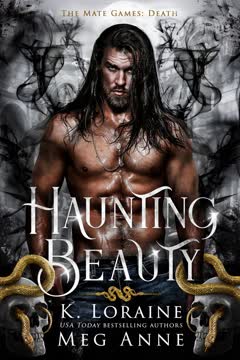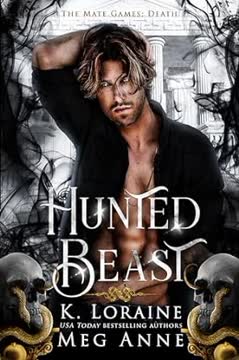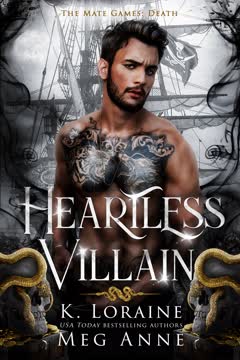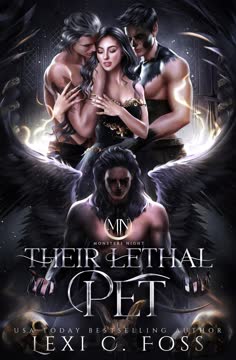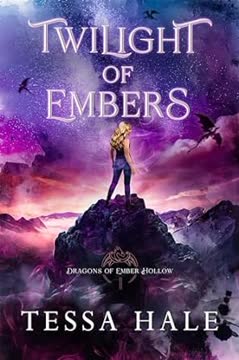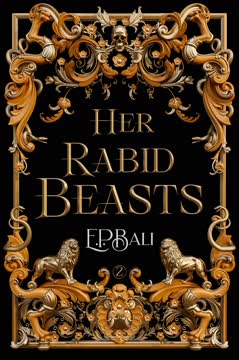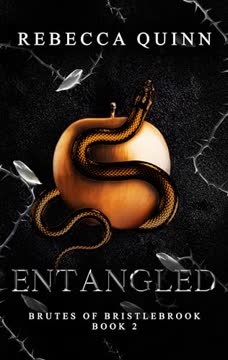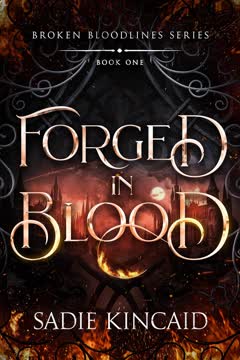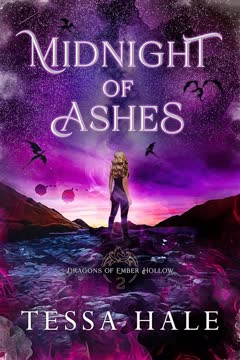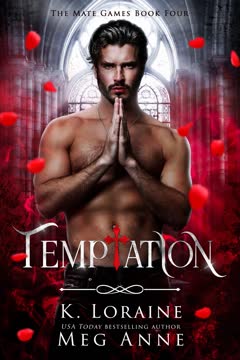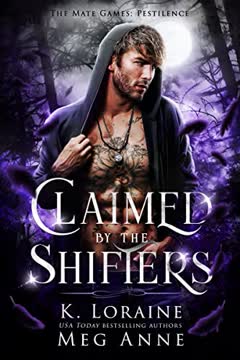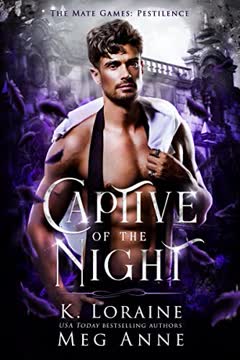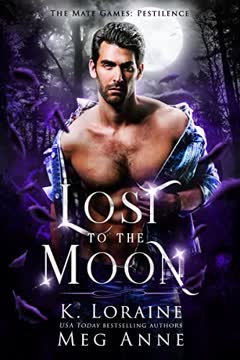Plot Summary
Through the Looking Glass
Dahlia Moore, a reclusive bestselling author with a notorious past, is thrust into the spotlight at her book's movie premiere. Her anxiety spirals when she sees her dead father in the crowd, triggering a public breakdown. Haunted by memories of her childhood in a cult and the trauma of her father's ritualistic violence, Dahlia's reality fractures. She's sent to Blackwood, a remote Scottish "wellness center" with a dark history, for recovery. The line between reality and delusion blurs as Dahlia's sense of self unravels, and she's forced to confront the ghosts—both literal and metaphorical—that have always haunted her.
The Blackwood Villains
At Blackwood, Dahlia is introduced to a peer accountability group of misfits: Cain, a man with no memory; Tor, a Norse demigod and berserker; Kai, a dragon shifter; and Caspian, the infamous Captain Hook. Their group therapy sessions, led by Dr. Masterson, are a chaotic blend of banter, trauma, and supernatural confessions. Each man claims a fantastical identity, and Dahlia, the only "normal" one, is forced to question her own sanity. The group's dynamic is volatile, with rivalries, flirtations, and secrets simmering beneath the surface, setting the stage for Dahlia's journey into the heart of Blackwood's mysteries.
Arrival at the Asylum
Blackwood is a sprawling Gothic castle, equal parts cozy and menacing. Dahlia's introduction is a whirlwind of eccentric residents, strict rules, and unsettling encounters. She meets Caspian, the flirtatious pirate; Dr. Masterson, the enigmatic psychiatrist; and a host of other supernatural beings, each with their own baggage. Dahlia's necklace, a childhood talisman, is confiscated as a "weapon," leaving her feeling exposed. Her first night is plagued by ghostly apparitions and the sense that Blackwood is alive with secrets. The castle's warmth is a thin veneer over the darkness lurking in its halls.
Monsters and Mates
Dahlia's skepticism is shattered as she witnesses impossible things: Tor's transformation into a horned beast, Kai's living dragon tattoo, and ghosts that interact with the living. The residents' claims of being vampires, shifters, and fae are no longer delusions but reality. Dahlia learns she is a psychic medium, able to see and interact with the dead. The group's therapy sessions become battlegrounds for dominance and desire, with Dahlia at the center. The men are drawn to her, each connection charged with fate and longing. The boundaries between patient and monster, reality and fantasy, begin to dissolve.
Ghosts of the Past
Under Dr. Masterson's guidance, Dahlia undergoes hypnotherapy to unlock repressed memories. She relives the night her father's cult tried to sacrifice her, her scream shattering the ritual and killing everyone present. The memory is raw and devastating, but it also reveals the origin of her power. Dahlia's past is not just a source of pain but the key to understanding her abilities. The ghosts she sees are not hallucinations but echoes of her trauma and her gift. The therapy is both a crucible and a catalyst, forcing Dahlia to confront the darkness within and around her.
The Pirate's Bargain
Caspian Hook is more than a charming rogue; he's a fae pirate with his own agenda. He traffics in pixie dust, bribes guards, and slips in and out of Blackwood at will. His flirtation with Dahlia is both genuine and strategic, masking a deeper loneliness and longing for connection. Caspian's escapades outside the asylum reveal a supernatural underworld teeming with danger and intrigue. His alliance with ghosts and his quest for a hidden key tie him to Blackwood's fate. For Dahlia, Caspian is temptation incarnate—a man who offers escape, pleasure, and peril in equal measure.
The Dragon's Chains
Kai, the dragon shifter, is tormented by guilt over a past rampage that destroyed a village. His magic is bound, his dragon locked away by enchanted tattoos. Kai's attraction to Dahlia is primal and possessive, but he fears losing control and hurting her. Their connection is electric, fueled by mutual longing and the thrill of danger. Kai's artistry—his tattoos, his sketches—becomes a way to channel his desire and his pain. As the supernatural threats at Blackwood escalate, Kai must decide whether to risk unleashing his dragon to protect the woman he's coming to love.
The Berserker's Curse
Tor, the Norse demigod, is cursed with a berserker's rage that threatens to consume him. Each transformation brings him closer to losing his humanity, symbolized by the withering petals of a black rose tattoo. Tor's sense of honor and duty is at war with his violent nature. His bond with Dahlia is instant and overwhelming—a fated mate connection that both soothes and provokes his beast. Tor's struggle is not just for control but for redemption. He seeks to protect Dahlia from himself, even as his need for her becomes impossible to deny.
The Shadow's Hunger
Cain is a man without a past, haunted by dreams of a lost love and flashes of violence. His power is shadowy and destructive, manifesting in blue fire and amnesia. As he grows closer to Dahlia, his protective instincts war with his fear of what he might be. Cain's connection to the other residents is fraught with rivalry and suspicion, especially as his memories begin to return. The truth of his identity—hinted to be something ancient and dangerous—looms over him. His relationship with Dahlia is a slow burn of denial, jealousy, and forbidden desire.
The Ripper's Game
The peace at Blackwood is shattered by a series of supernatural murders. The Ripper, a serial killer who targets powerful creatures and takes trophies tied to their gifts, is on the loose. The residents are both suspects and potential victims. Dahlia's psychic abilities draw her into the investigation, as the ghosts of the Ripper's victims seek her help. Paranoia and fear spread through the castle, alliances shift, and old wounds are reopened. The killer's true goal is revealed to be connected to Dahlia herself—she is the ultimate prize in a deadly game.
Tangled Hearts, Tangled Sheets
The tension between Dahlia and her suitors erupts into passion and conflict. Caspian seduces her with daring public pleasure; Kai worships her with dragon-fueled intensity; Tor claims her with primal devotion; and even Cain, despite his resistance, is drawn into her orbit. Their connections are messy, overlapping, and charged with jealousy. The group's therapy sessions become arenas for emotional and sexual vulnerability. Dahlia, once isolated by trauma, finds herself at the center of a polyamorous web—desired, protected, and challenged by men who are as broken as she is.
The Power of Names
The concept of "mate" and the power of choice become central. Tor's use of "Kærasta" (mate) is both a vow and a binding. Dahlia must choose whether to accept the claim, knowing it will change her forever. The men grapple with their own desires and the meaning of sharing, each forced to confront what it means to love and be loved by someone who is not theirs alone. The act of naming—of calling, claiming, and being seen—becomes a source of both power and vulnerability. Dahlia's journey is one of reclaiming her agency and her identity.
Blood and Bone
The supernatural threats escalate as the Ripper's killings grow bolder. Tor avenges an attack on Dahlia by ripping out a vampire's fangs and presenting them as a trophy. The boundaries between protector and predator blur, as the men's possessiveness becomes both a shield and a danger. The violence at Blackwood is not just external but internal—each character is at war with their own nature. The cost of survival is high, and the line between justice and vengeance is razor-thin. Blood and bone are the currency of love and power in this world.
The Unraveling
The group's fragile unity is shattered by betrayal, jealousy, and the revelation of hidden agendas. Caspian's use of pixie dust to manipulate Cain, Kai's failed attempt to bind his dragon, and Tor's struggle to control his beast all come to a head. The Ripper's true identity remains elusive, but the danger is closer than anyone realizes. Dahlia's powers grow, drawing her deeper into the supernatural web. The ghosts become more insistent, the boundaries between life and death thinner. The group must decide whether to trust each other or risk being destroyed from within.
The Claiming
In a moment of crisis, Tor and Dahlia consummate their bond, completing the mate ritual. The act is both ecstatic and terrifying, binding their souls and granting Tor the control he needs to hold back his beast. The claiming is not just physical but metaphysical—a merging of hearts, bodies, and destinies. The other men are forced to reckon with the new reality, their own desires and claims thrown into question. For Dahlia, the claiming is both liberation and loss—a step into a new life that cannot be undone.
The Beast Unleashed
The fragile peace is shattered as Blackwood's most dangerous prisoners are released. Tor, now fully claimed but on the edge of losing himself, transforms into his berserker form to protect Dahlia from a horde of monsters. The battle is brutal and bloody, a test of love and loyalty. The other men must choose whether to fight for Dahlia or for themselves. The cost of survival is high, and not everyone will make it out unscathed. The line between hero and monster is obliterated in the crucible of violence.
The Apocalypse Begins
In the aftermath, it's revealed that the chaos at Blackwood is part of a larger, apocalyptic scheme orchestrated by Death herself. The events at the asylum are just one move in a cosmic game, with Dahlia and her mates as key pieces. The boundaries between love and destruction, fate and free will, are blurred. The story ends on a cliffhanger, with the promise of further trials, deeper bonds, and the looming threat of the end of the world. Dahlia's journey is far from over—the true game has only just begun.
Characters
Dahlia Moore
Dahlia is a bestselling author whose fame is shadowed by her traumatic past as the daughter of a cult leader. Plagued by anxiety, repressed memories, and a psychic gift she doesn't understand, Dahlia is thrust into Blackwood after a public breakdown. Her journey is one of reclamation—of her power, her sexuality, and her agency. Dahlia is both vulnerable and resilient, drawn to the monsters around her even as she fears becoming one herself. Her relationships with the men of Blackwood are complex, blending desire, fear, and the longing for connection. Dahlia's arc is about learning to trust herself, to embrace her gifts, and to choose love in the face of darkness.
Tor Nordson
Tor is a Norse demigod burdened by a berserker's curse that threatens to strip him of his humanity. His rage is both a weapon and a prison, symbolized by the withering petals of a black rose tattoo. Tor's sense of honor and duty is at war with his violent nature. His bond with Dahlia is instant and overwhelming—a soul-deep connection that both soothes and provokes his beast. Tor's journey is one of redemption, as he fights to protect Dahlia from himself and the world. His arc is about learning to accept love, to trust in fate, and to find peace in the arms of his mate.
Malakai "Kai" Nash
Kai is a fae dragon shifter whose power is bound by magical tattoos, a punishment for a past rampage. He is haunted by guilt and the fear of losing control. Kai's attraction to Dahlia is primal, possessive, and deeply sensual. His artistry—both in ink and in passion—is a way to channel his longing and his pain. Kai's struggle is to reconcile his dual nature, to find balance between the man and the beast. His arc is about risking vulnerability, embracing desire, and fighting for a love he fears he doesn't deserve.
Caspian Hook
Caspian is the infamous Captain Hook, a fae trickster who traffics in pixie dust and secrets. His bravado masks a deep loneliness and a longing for connection. Caspian's flirtation with Dahlia is both genuine and strategic, a way to stave off the emptiness inside. His alliances with ghosts and his quest for a hidden key tie him to Blackwood's fate. Caspian's arc is about learning to be more than a mask, to risk real intimacy, and to fight for something greater than himself.
Cain Alexander
Cain is a man without a past, haunted by dreams of a lost love and flashes of violence. His power is shadowy and destructive, manifesting in blue fire and amnesia. Cain's connection to Dahlia is fraught with denial, jealousy, and forbidden desire. He is both drawn to her and terrified of what he might become. Cain's arc is about reclaiming his identity, confronting the darkness within, and choosing whether to be a monster or a man.
Dr. Elizabeth Masterson
Dr. Masterson is the head of Blackwood, a psychiatrist with her own supernatural ties. She is both guide and gatekeeper, orchestrating the therapy sessions and the residents' journeys. Her methods are unorthodox, blending science and magic. Dr. Masterson's relationship with the residents is complex—part mentor, part manipulator. She is driven by a desire to heal, but also by a fascination with the monsters in her care. Her arc is about the limits of control, the ethics of power, and the cost of playing god.
Sorcha Blackthorne
Sorcha is a vampire with a reputation for abusing her compulsion powers. She is both ally and threat, her loyalty shifting with her interests. Sorcha's relationship with Dahlia is one of wary respect, tinged with rivalry and shared trauma. She represents the seductive danger of the supernatural world, as well as the possibility of redemption.
Oz
Oz is a telepath whose powers have left a trail of broken minds in his wake. He is both comic relief and a source of insight, his banter masking deep pain. Oz's relationship with Dahlia is one of camaraderie and mutual understanding. He is a reminder that power is both a gift and a curse.
Bruno
Bruno is Tor's handler, a mage strong enough to restrain a berserker. He is both friend and jailer, tasked with keeping Tor—and by extension, everyone else—safe. Bruno's arc is about the burden of responsibility, the limits of loyalty, and the cost of caring for those who are dangerous.
Death (The Horseman)
Death is the unseen architect of the chaos at Blackwood, orchestrating events as part of a larger apocalyptic scheme. She is both antagonist and force of nature, her motives inscrutable and her power absolute. Death's arc is about the inevitability of endings, the seduction of power, and the thin line between creation and destruction.
Plot Devices
Therapy as crucible and confessional
The recurring therapy sessions at Blackwood serve as both a crucible and a confessional, forcing characters to confront their traumas, desires, and secrets. The sessions are structured as transcripts, blending humor, vulnerability, and revelation. This device allows for deep character exploration, the unearthing of backstory, and the escalation of interpersonal conflict. Therapy is both a tool for healing and a stage for rivalry, desire, and transformation.
Supernatural as metaphor for trauma
The supernatural elements—shifters, vampires, fae, ghosts—are not just worldbuilding but metaphors for trauma, addiction, and mental illness. Each character's monstrous nature reflects their psychological wounds: Tor's berserker rage as PTSD, Kai's bound dragon as repressed guilt, Caspian's fae glamour as a mask for loneliness, Cain's amnesia as dissociation. The line between monster and victim is blurred, inviting readers to question what it means to be "broken" or "dangerous."
Polyamory and the power of choice
The central romantic arc is a polyamorous web, with Dahlia at the center. The concept of "mate" is both a supernatural bond and a metaphor for the power of naming, claiming, and being seen. The story explores the tension between fate and free will, the ethics of sharing and jealousy, and the possibility of loving more than one person. The act of choosing—who to trust, who to love, who to be—is a recurring motif.
Foreshadowing and cosmic games
The narrative is laced with foreshadowing of a larger, cosmic game. The Ripper's killings, the release of Blackwood's monsters, and the therapy sessions are all moves in Death's apocalyptic scheme. The story is structured as a slow-burn mystery, with clues and red herrings scattered throughout. The use of transcripts, flashbacks, and shifting points of view creates a sense of inevitability and suspense, building toward the revelation of Death's master plan.
Ghosts as memory and warning
The ghosts at Blackwood are both literal and symbolic—manifestations of trauma, guilt, and unfinished business. They serve as guides, warnings, and mirrors for the living. Dahlia's ability to see and interact with the dead is both a gift and a curse, drawing her into the heart of the Ripper's game and forcing her to confront her own past. The boundaries between life and death, memory and reality, are porous and unstable.
Analysis
Haunting Beauty is a lush, subversive reimagining of the gothic romance, blending supernatural intrigue with raw psychological realism. At its core, the novel is an exploration of trauma—how it shapes identity, distorts reality, and both isolates and connects us. Blackwood is less an asylum than a crucible, a place where the broken and the monstrous are forced to confront the parts of themselves they most fear. The polyamorous romance at the heart of the story is both a fantasy of abundance and a meditation on the ethics of desire, consent, and sharing. The supernatural elements are not mere window dressing but metaphors for the wounds we carry: rage, guilt, dissociation, the longing to be seen and claimed. The therapy sessions, with their blend of banter and confession, are a brilliant device for character development and thematic exploration. The looming apocalypse, orchestrated by Death herself, reframes the personal struggles of the characters as part of a larger cosmic game—one in which love, power, and survival are always intertwined. Ultimately, Haunting Beauty is a story about the courage to choose connection over isolation, to embrace the monstrous within, and to find beauty in the haunted places of the soul.
Last updated:
Review Summary
Haunting Beauty is a popular paranormal reverse harem romance set in a supernatural asylum. Readers praise the engaging plot, complex characters, and steamy romance between the protagonist Dahlia and her four love interests. Many highlight the excellent audiobook narration with a full cast. The book is noted for its mix of humor, spice, and darker themes. While some found it confusing or disliked certain aspects, most reviewers eagerly anticipate the next installment in the series.
The Mate Games: Death Series
Similar Books
Download PDF
Download EPUB
.epub digital book format is ideal for reading ebooks on phones, tablets, and e-readers.
